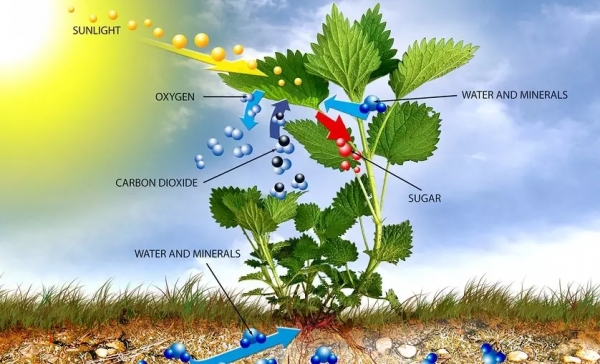
 Data Structure
Data Structure Networking
Networking RDBMS
RDBMS Operating System
Operating System Java
Java MS Excel
MS Excel iOS
iOS HTML
HTML CSS
CSS Android
Android Python
Python C Programming
C Programming C++
C++ C#
C# MongoDB
MongoDB MySQL
MySQL Javascript
Javascript PHP
PHP
- Selected Reading
- UPSC IAS Exams Notes
- Developer's Best Practices
- Questions and Answers
- Effective Resume Writing
- HR Interview Questions
- Computer Glossary
- Who is Who
How do plants make their own food?
Plants are not parasitic in nature. They produce their own food with the help of their growth and nutrition. Plants make their own food by a process called Photosynthesis. Photosynthesis is a process used by plants and other organisms to convert light energy into chemical energy and stored in the form of starch which can be used later.

Photosynthesis is a key process in the growth of plants.
Photosynthesis is done with the help of carbon-dioxide, water, and sunlight. The end products of photosynthesis are oxygen, which the plants release, and carbohydrates, which become the plants' source of energy.
Building on the basic structure of glucose, plants also use photosynthesis to create several more complex carbon-based chemicals essential to their growth and survival.
The process starts with the water absorbed through the roots which rise to the leaves to enter cells called "CHLOROPLASTS". They contain a green pigment called "CHLOROPHYLL" which also helps in giving the green colour to plants by reflecting green wavelengths.

More importantly, chlorophyll absorbs light in the red and blue parts of the spectrum and uses it to power a crucial chemical reaction.
Inside the chloroplast, chlorophyll molecules absorb a single photon of light and in exchange for an electron. A series of chemical reactions follow, which ultimately replaces the lost electron from water molecules in the leaf. In the process, the oxygen atom in the water separates from the hydrogen atoms and passes out as waste. Then the remaining hydrogen is collected and synthesized to form carbohydrate molecules.
The process that creates the actual food for the plant does not require light, so it's called a dark reaction. In another part of the leaf called the Stroma, carbon dioxide that's been absorbed from the environment is reduced into carbon and oxygen.
Even this time, the oxygen is allowed to escape only to allow hydrogen to combine with carbon to get the end product of the first process which is a simple sugar. They can be combined to produce any organic compound which the plant might need, it maybe for the structure or nutrition.

The light energy is not used directly, but it is converted into chemical energy. Out of all the light that hits the leaf only a 5% of it is used for Photosynthesis. Only 30-50% of it is stored as chemical energy in the cell.
Scientists believe it was photosynthesis in early green plants and algae that created Earth's breathable atmosphere. Even today, plants continue to replenish the environment, filtering harmful carbon dioxide into life-sustaining oxygen.
Photosynthesis is believed to be the most vital process as it not only helps in growth of plants but also it gives human beings the oxygen required to live. Thus plants not only make their own food but also maintain the ecosystem of the earth.

